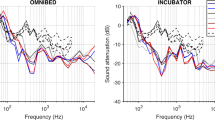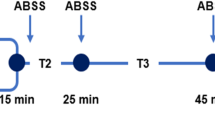Abstract
OBJECTIVE: To present the conclusions and associated recommendations for care developed by the Physical and Developmental Environment of the High-Risk Infant Center, Study Group on Neonatal Intensive Care Unit (NICU) Sound, and the Expert Review Panel.
STUDY DESIGN: A multidisciplinary group of clinicians and researchers reviewed the literature regarding the effect of sound on the fetus, newborn, and preterm infant and developed recommendations based on the best evidence. An Expert Review Panel reviewed the data and conclusions.
RESULTS: The following recommendations are developed from the review of the literature and are clarified in the body of the article. (1) Women should avoid prolonged exposure to low-frequency sound levels (<250 Hz) above 65 dB(A) during pregnancy. (2) Earphones or other devices for sound production should not be used directly attached to the pregnant woman's abdomen. (3) The voice of the mother during normal daily activities, along with the sounds produced by her body and those present in her usual surroundings, is sufficient for normal fetal auditory development. The fetus does not require supplemental stimulation. Programs to supplement the fetal auditory experience cannot be recommended. (4) Infant intensive care units should incorporate a system of regular noise assessment. (5) Sound limit recommendations are to maintain a nursery with an hourly Leq of 50 dB(A), an hourly L10 of 55 dB(A) and a 1-second Lmax of 70 dB(A), all A-weighted, slow response scale. (6) Infant intensive care units should develop and maintain a program of noise control and abatement in order to operate within the recommended permissible noise criteria. (7) Care practices must provide ample opportunity for the infant to hear parent voices live in interaction between parent and infant at the bedside. (8) Earphones and other devices attached to the infant's ears for sound transmission should not be used at any time. (9) There is little evidence to support the use of recorded music or speech in the environment of the high-risk infant. Audio recordings should not be used routinely or left unattended in the environment of the high-risk infant.
CONCLUSION: The recommendations, if followed, should provide an environment that will protect sleep, support stable vital signs, improve speech intelligibility for the infant, and reduce potential adverse effects on auditory development.
This is a preview of subscription content, access via your institution
Access options
Subscribe to this journal
Receive 12 print issues and online access
$259.00 per year
only $21.58 per issue
Buy this article
- Purchase on Springer Link
- Instant access to full article PDF
Prices may be subject to local taxes which are calculated during checkout
Similar content being viewed by others
Author information
Authors and Affiliations
Rights and permissions
About this article
Cite this article
Graven, S. Sound and the Developing Infant in the NICU: Conclusions and Recommendations for Care. J Perinatol 20 (Suppl 1), S88–S93 (2000). https://doi.org/10.1038/sj.jp.7200444
Published:
Issue Date:
DOI: https://doi.org/10.1038/sj.jp.7200444
This article is cited by
-
The impact of sound stimulations during pregnancy on fetal learning: a systematic review
BMC Pediatrics (2023)
-
Prevention of severe brain injury in very preterm neonates: A quality improvement initiative
Journal of Perinatology (2022)
-
Preterm infants with severe brain injury demonstrate unstable physiological responses during maternal singing with music therapy: a randomized controlled study
European Journal of Pediatrics (2021)
-
Neonatal intensive care unit incubators reduce language and noise levels more than the womb
Journal of Perinatology (2020)
-
Evaluating physiologic outcomes of music interventions in the neonatal intensive care unit: a systematic review
Journal of Perinatology (2020)



